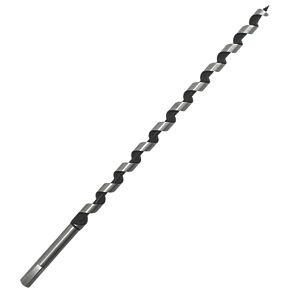- Joined
- 14 Nov 2022
- Messages
- 12
- Reaction score
- 0
- Country

Hi all.
I recently put up an oak sleeper retaining wall in my garden and now want to finish it off by interlocking the three wooden layers using some hardwood dowel pegs hammered into augered holes.
The wall comprises three 200mm wide sleepers on top of each other laid on their short 100mm wide side. It is supported by uprights to which they have been coach bolted (stainless).
I have already augered several 12mm holes through the bottom two (400mm) into which I rammed some 700mm stainless rods so there was a foot in the ground. I’d like to now connect the top two layers with wooden dowel.
Trouble is, while my cordless drill (40nm torque) was fine augering the 200mm 12mm holes for the coach bolts, it struggled a little with the 400mm for the steel rods. It made it in the end by pouring some oil into the threads of the bit and taking it slow, clearing out the wood dust.
I even tried my friends blue Bosch 1100W mains hammer drill but it had the same issue. I was surprised at this, I thought it would make mincemeat of the augering. Obviously it wasn’t on hammer mode!
All this makes me apprehensive about doing the 24mm x 400mm augers. Would you guys have any tips for getting this done? What drill would you go for?
The bits I’m using are these. https://www.toolstation.com/long-auger-bit-set/p35978
The 12mm was surprisingly good!
Thanks
H
I recently put up an oak sleeper retaining wall in my garden and now want to finish it off by interlocking the three wooden layers using some hardwood dowel pegs hammered into augered holes.
The wall comprises three 200mm wide sleepers on top of each other laid on their short 100mm wide side. It is supported by uprights to which they have been coach bolted (stainless).
I have already augered several 12mm holes through the bottom two (400mm) into which I rammed some 700mm stainless rods so there was a foot in the ground. I’d like to now connect the top two layers with wooden dowel.
Trouble is, while my cordless drill (40nm torque) was fine augering the 200mm 12mm holes for the coach bolts, it struggled a little with the 400mm for the steel rods. It made it in the end by pouring some oil into the threads of the bit and taking it slow, clearing out the wood dust.
I even tried my friends blue Bosch 1100W mains hammer drill but it had the same issue. I was surprised at this, I thought it would make mincemeat of the augering. Obviously it wasn’t on hammer mode!
All this makes me apprehensive about doing the 24mm x 400mm augers. Would you guys have any tips for getting this done? What drill would you go for?
The bits I’m using are these. https://www.toolstation.com/long-auger-bit-set/p35978
The 12mm was surprisingly good!
Thanks
H

